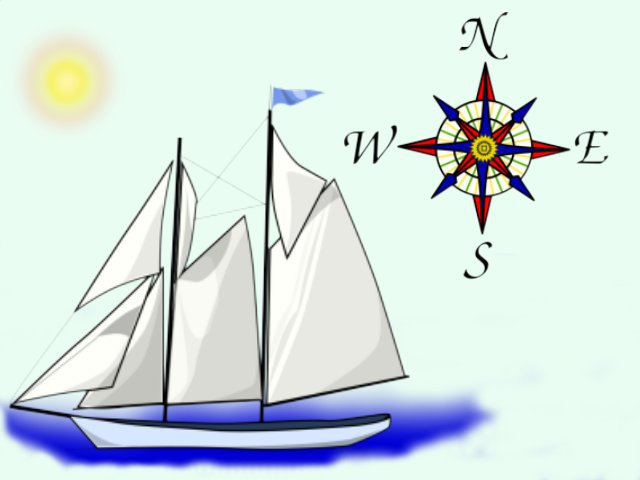Introduction to Genealogy
Immigrant Women: Our Courageous Ancestors
October 14, 2012 by ramona
Filed under Articles, Genealogy Technology, Latest News
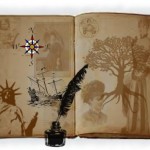 The book Immigrant Women, By Maxine Seller gives insight into the first impressions, hard lessons, joys and sorrows experienced by women who immigrated during the 19th and 20th centuries. In a collection of memoirs, oral histories, diaries and stories, the book records the specific struggles of women striving to build a new life in a new land.
The book Immigrant Women, By Maxine Seller gives insight into the first impressions, hard lessons, joys and sorrows experienced by women who immigrated during the 19th and 20th centuries. In a collection of memoirs, oral histories, diaries and stories, the book records the specific struggles of women striving to build a new life in a new land.
Most of the time we can only imagine what challenges our immigrant grandmothers faced and what they thought of their new home. Genealogy can only tell us so much: it is a treasure to read it in their words.
Excerpts
In her own words Marie Prisland, an immigrant from Slovinia, describes her arrival at Ellis Island in 1906. Her entry includes an eye opening description of what it was like the first time she became aware of cultural differences.
“An English speaking immigrant asked the near-by guard where we could get a drink of water. The guard withdrew and returned shortly with a pail of water, which he set before the group of women. Some men stepped forward quickly to have a drink, but the guard pushed them back saying: “Ladies First!” When the women learned what the guard had said, they were dumbfounded, for in Slovinia as in all Europe, women always were second to men.”
Leaving behind friends and family could lead to a lonely existence for many women as can be seen in this Norwegian immigrant women’s song.
Farewell, my old spinning wheel. How I shall miss you;
The thought of leaving you breaks the heart in my breast.
No more in the evening will we sit by the fireside, old friend of mine
and gossip together.
Ah, all that I see has its roots in my heart. And now they are torn out
Do you wonder it bleeds?
Immigrant Women, speaks in the voices of our grandmothers, engaging us in a narrative that opens a window into the past.
You can read Immigrant Women, free on Google books.
Genetic Genealogy, Historic Figures and Your DNA
October 5, 2012 by ramona
Filed under Articles, Genealogy Technology, Introduction to Genealogy, Latest News
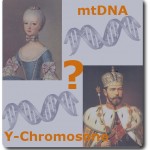 The world of genealogy is filled with family history stories connecting us to famous ancestors. After all, who wouldn’t want to include a celebrated historical figure in their family tree?
The world of genealogy is filled with family history stories connecting us to famous ancestors. After all, who wouldn’t want to include a celebrated historical figure in their family tree?
What if DNA testing could add fact to family fiction?
Recently I ran across a few websites that offered DNA testing for the purpose of matching clients DNA to that of famous historical figures. While I understand the allure of such testing, I have to admit that the skeptic in me was rather doubtful.
Among the historical figures listed were:
- King Tut
- Napolean Bonaparte
- Marie Antoinette
- Jesse James
- Genghis Khan
- Zar Nicholas Romanov
- Sven II Estridsen (Viking King of Denmark)
- Luke the Evangelist
- Petrarca (Italian Poet)
- Thomas Jefferson – Sally Hemmings
How it Works
In the case of some of the notables listed above, DNA samples have been gathered through various methods.
For instance, Marie Antoinette’s DNA was extracted from a lock of her hair and remains of one of her children. Jesse James DNA came from hair and bone fragments collected after an exhumation of his body. The DNA samples used for comparing DNA profiles with Napolean Bonaparte and Thomas Jefferson came from known descendants of these legendary figures.
So, how can they tell if you are a descendant of Genghis Khan, or ancient Irish and Scottish kings? The process of determining this comes from testing (on a very broad scale) to determine matches – or at the least – strong associations among DNA signatures and surnames. For example in the case of ancient Irish king, Nial of the Nine Hostages, geneticists studied 17 STR markers on the Y-chromosomes of a broad selection of Irish men. What they found was a connection between the DNA signature and several surnames.
Using DNA to establish your relationship to a famous historical figure works best in a controlled setting such as a one-name study. A good example of this is a study that already has a sample of DNA belonging to someone with a solid paper trail…AKA…a known descendant.
While these sites claim that they can match clients with historical figures, in most cases, they can only determine the likelihood of a relationship or tell if you share a common ancestor. The truth is that while genetic genealogy is a great tool…you will also need to do things the old-fashioned way and establish a paper trail.
Do Genealogy Specific Search Engines Simplify Your Family Tree Research?
September 11, 2012 by ramona
Filed under Articles, Genealogy Technology, Introduction to Genealogy, Latest News
Have you ever wished for a genealogy exclusive search engine that could: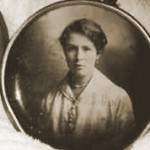
Organize and simplify your family tree research?
Cut out all of the garbage returns and zero in on your specific search criteria?
Do it FAST and FREE
A search engine like this is on the top of my family history wish list and while it seems that every other genealogy search engine I come across is making claims that their tools use the ultimate in “Intelligent Search” or “Smart Technology”: I have yet to find one that fulfills all promises made.
In reality, what I have found is that most sites that make these claims simply redirect you to the major known genealogy sites or query boards.
While Mocavo comes close and Google does an excellent job with the right search terms the best strategy is simply gather up your family tree templates and go straight to a reputable record source such as Family Search, Ancestry.com or the archive/repository for the area you are searching.
In fact, if your search is geography specific it may be more worth your time and money to join the family history society that covers your specific location.
Finding the all the time you want to spend researching your family tree can be hard enough without wasting it on useless searches that yield few results.
Free Online Genealogy Books
September 7, 2012 by ramona
Filed under Articles, Genealogy Technology, Introduction to Genealogy, Latest News
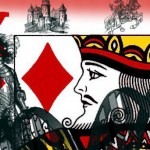 Something that always gets me excited about genealogy is finding great free resources online, especially ones that are:
Something that always gets me excited about genealogy is finding great free resources online, especially ones that are:
1. Unique
2. Packed with family history information
3. Available on other sites for a fee
Recently I discovered one on Google Books that I thought might be just as exciting for others researching their family tree whether they are experienced genealogists or genealogy beginners.
A Genealogical and Heraldic History of the Commoners of Great Britain and Ireland
A Genealogical and Heraldic History of the Commoners of Great Britain and Ireland, written by John Burke is a four-volume book published in the mid 1800s that contains information on almost 400 families in the first volume alone. What makes the book unique is that it contains information on people who were either landowners or held rank…but were not among the titled gentry.
Family History Information
Within the biographies contained between the covers, you will find names, vital events, occupations and geographic information on these families as well as specifics on individual members.
To give you an at-a-glance idea of what you may find let us look at the Beckford family of Fonthill.
The entry begins by identifying one William Beckford esq. of Fonthill Abbey in the county of Wilts. Who married the daughter of the fourth Earl of Aboyne . In a short introduction to his biography we learn that the William was a member of parliament and inherited his estates from his father.
Below the biography is the Lineage section which starts off with the origin of the family and continues on with short history including the military history of several family members.
Far from a dry pedigree, this family record includes such tit-bits as: Mr. Beckford is descended (Paternally or maternally) from all the Barons of the Magna Carta and had among his ancestors another William who was twice Lord Mayor of London.
At the end of the book family tree fanatics will find an appendix that lists:
- Banneretts and Knights made after the battles of Stoke and Blackheath by King Henry VII
- Officers commanding the queens forces anno 1569
- Knights of the Royal Oak
Want More Great Family Tree Resources?
Some other great free genealogy books that can be found on Google Books include:
- The knightage of Great Britain and Ireland
- The Court Journal: Court Circular & Fashionable Gazette: Volume 7
- Burke’s Peerage, Baronetage & Knightage: Clan Chiefs, Scottish Feudal Barons, Volume 1
- A Genealogical and Heraldic History of the Colonial Gentry
- Complete peerage of England, Scotland, Ireland, Great Britain
- Burke’s Royal Families of the World: Africa & the Middle East
Irish Surname Resources
July 23, 2012 by ramona
Filed under Articles, Genealogy and Surnames, Introduction to Genealogy, Latest News
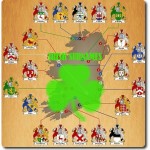 Are you an O’Mally or an O’Neil?
Are you an O’Mally or an O’Neil?
If you are a genealogy beginner in search of Irish surname resources you are in luck because you are among the millions of fortunate family tree fanatics who can draw from a wide variety of genealogy resources.
To get started you might want to check out this fantastic Irish Surname Infographic which gives an at-a-glance overview of the top twenty most common Irish surnames.
Other information you can find on the infographic include:
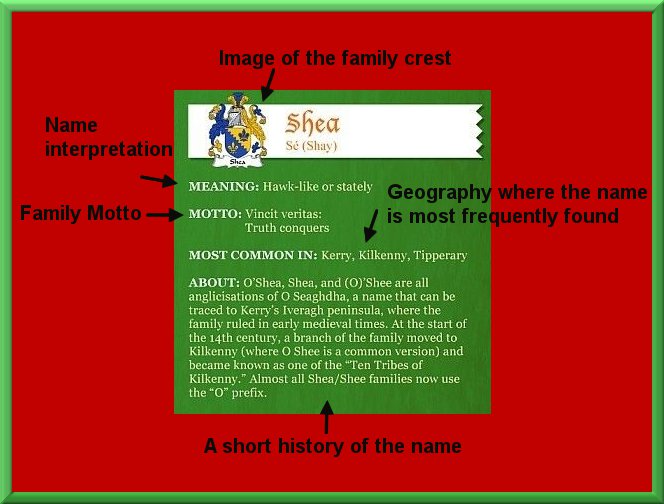
Another fantastic resource to check out is Irish Central an online magazine packed with all things Irish including an in depth article explaining the top 100 Irish surnames.If you already know about your Irish surname and you are ready to start digging deep for your Irish roots try stopping by Irish Genealogy where you can search almost three million pre-20th century Church records for FREE.
Want more resources? Try Genuki Ireland for links on where to research:
INFORMATION RELATED TO ALL OF IRELAND
|
|
Before you get started on your Irish family history research, don’t forget to download your Research tracking forms and Family Tree Charts. Available with your 30-Day FREE TRIAL MEMBERSHIP to Genealogy Beginner
Genealogy: Online Ethics and Etiquette
July 11, 2012 by ramona
Filed under Articles, Genealogy Standards & Guidelines, Introduction to Genealogy, Latest News
 From the novice to the veteran family historian we can all agree that the vast amount of information available online for genealogy research is a great blessing. Therefore, it is more important than ever to become familiar with the ethical practices and etiquette involved in information sharing when it comes to our family trees.
From the novice to the veteran family historian we can all agree that the vast amount of information available online for genealogy research is a great blessing. Therefore, it is more important than ever to become familiar with the ethical practices and etiquette involved in information sharing when it comes to our family trees.
On sites such as Ancestry.com and Find a Grave, a great deal of the information is made available through the contributions of fellow researchers. Thus, it is becoming easier for genealogy beginners to discover documents and photos at the touch of a few keys.
Family Tree Ethics and Etiquette
Published genealogies can be a truly wonderful resource, they aid us in our own research and quite often lead to the discovery of cousins we never knew we had. The down side of this is that through innocent error and sometimes intent, the genealogical community experiences a degree of unethical behavior and bad manners.
It is very exciting to find published information about your ancestors online however, before you snag that birth, marriage, death record or photo of G.G. Grandma:
1. Ask Permission
This is a common scenario on sites like Ancestry.com where photos and records are often public. This is because Ancestry.com is meant to be a collaborative site and although it states in their Community Guidelines that “Any information you post in our community is public and can be copied, modified and distributed by others” you should still ask permission of the original poster.
2. Give Credit
When using published documents or photos always thank the original contributor A little blurb that reads – Photo Courtesy of Ms. Nice Genealogist – is just good manners.
To learn more about this subject check out Genealogy Beginner’s lesson # 1. Genealogy Standards and Guidelines: You Need to Know This First, available with your 30-day free trial membership.
Searching for Immigrant Ancestors
June 16, 2012 by ramona
Filed under Articles, Getting Started in Genealogy, Introduction to Genealogy, Latest News
 Unless you are of aboriginal descent, your ancestors came to North America as immigrants.
Unless you are of aboriginal descent, your ancestors came to North America as immigrants.
Europeans have been making the journey to North American shores since the first recorded settlement by Vikings in L’Anse aux Meadows (Newfoundland, Canada) in 1000 AD. Although colonization truly did not begin until 1492 when Columbus headed his Spanish expedition in search of trade routes and instead found a new land.
In the following centuries, the North American population grew with immigrants of all races and nationalities. From those seeking religious freedoms to those who suffered forced immigration. They came by ship in droves and ever since, we have been looking back, seeking our immigrant ancestors.
The Immigration Brick Wall
For many beginning genealogists this is the point where they first encounter a brick wall in their research. Up to this point, the search for records has been confined to home shores and filling out the spaces on family tree charts has gone relatively smoothly. Then all of a sudden your ancestors disappear from the records… and you do not know where they went.
This is often the point in family history research where new researchers first come across an immigrant ancestor. Unless family bibles and/or stories offer a clue, it leaves researchers asking the questions. Where do I look now, who am I looking for and when did they emigrate?
Immigration and Name Changes
Before you can know where and when to look you will need to know who it is you are looking for. This may sound like a silly statement however; it is not unusual for immigrant ancestors to change their names. Name changes happened for a multitude of reasons from letter combinations and symbols that were not compatible with the English language to a desire to sound more American.
For example, you may have found a family patriarch listed in North American records as John Weaver but if he emigrated from Germany, you may actually need to be searching for Johan Webber.
Where to Begin Your Search
If the ancestor you are hunting for came from overseas, you may not have a birth or marriage record to answer the question of where they came from. Three excellent sources to consult should this be the case are:
- Census Records (which could also give you a clue as to when they emigrated)
- Death Records (if country of birth is not listed the names of listed parent could offer a clue)
- Newspapers (Wedding and anniversary announcements in addition to obituaries often contain biographical information that could aid in pinpointing your ancestors country or birth)
When Did They Emigrate
Your best starting point for unearthing the date of your ancestors emigration is the census records. The first census for the United States was taken before the ratification of the American Constitution in 1790. Since then a Census was taken every ten years.
In Canada, the first census occurred in 1666 in what was then New France. However, the first national census was not taken until 1871 and was followed by subsequent enumerations every five years. Locating the first census your ancestor was found in should help narrow down your search for an emigration year.
Once you have the data your next step is to begin locating records of immigration and ships lists. A visit to Library and Archives Canada or the US National Archives should be your first stop, as they will direct you to further research sources.
Do not forget to sign up for a 30-day free trial membership to Genealogy Beginner and download your complimentary family tree charts and research tracking forms.
Family Tree: Understanding Cousin Relationships
June 4, 2012 by ramona
Filed under Articles, Genealogy Reports and Charts, Introduction to Genealogy, Latest News
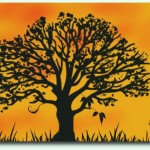 Relationship charts are a great tool for understanding your family tree…when you know how to use them. However, for the genealogy beginner they can be a little confusing.
Relationship charts are a great tool for understanding your family tree…when you know how to use them. However, for the genealogy beginner they can be a little confusing.
The purpose of a relationship chart is to help you identify the first common ancestor shared between you and a non-immediate family member such as a cousin.
For example, by looking at the first two rows of a family relationship chart you can see that the first common ancestor you share with a sibling is a parent, you share a grand parent with a niece or nephew and a great-grandparent with a great-niece or nephew.

This all seems straightforward until you start going down the chart and run into “cousins removed”. So what is a cousin “removed”? The easiest way to understand this is to think of it in terms of how many generations there are between first and second cousins and then go one-step further.
A first cousin is the child of an uncle or aunt and the first common ancestor you share is a grand parent.
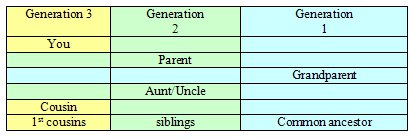
Second cousins are separated by another generation. Simply put second cousins are the children of first cousins. Both children are separated by two generations from their common ancestor.

To understand cousins once removed lets go that extra step. Your cousin once removed is a cousin of your parent.
- The common ancestor of you and your first cousin once removed are your great-grandparents
- There are two generations separating you from your great-grandparents (your parents and your grandparents)
- There is one generation separating your first cousin once removed from your great-grandparents (your great-uncle/aunt).
Since your parents cousin (your first cousin once removed) is one generation closer to your common ancestor there is one generation or “degree” of difference between the relationships you and the “cousin” share with the common ancestor.

One rule to help remember “removed” relationships are that there is always an unequal distance (grey squares) between the “removed” cousins and the common ancestor, while cousins that are not removed will have an equal distance (pink squares) between the common ancestor.
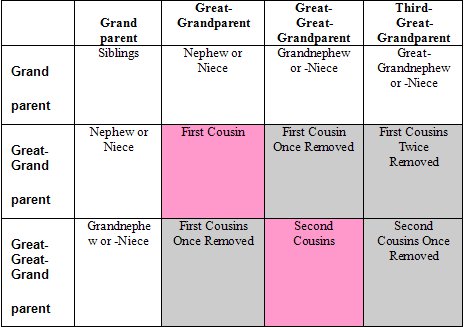
Did you know that in over ten generations you could have well over two thousand direct line ancestors?
Two parents + four grandparents + eight great-grandparents + sixteen great-great-grandparents + thirty two great-great-great-grandparents + sixty four great-great-great-great-grandparents + one hundred twenty eight great-great-great-great-great-grandparents + two hundred fifty six great-great-great-great-great-great-grandparents + five hundred twelve great-great-great-great-great-great-great-grandparents + 1,024 great-great-great-great-great-great-great-great-grandparents (2+4+6+8+16+32+64+128+512+1024) = 2046 direct ancestors in ten generations.
Sign up today for a Free Trial membership with Genealogy Beginner and you will receive a Family Relationship Chart as part of your Family Tree Starter Kit.
Deep Ancestry and a Rediscovered Scottish Tribe
May 1, 2012 by ramona
Filed under Articles, Genealogy Technology, Introduction to Genealogy, Latest News
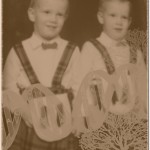 Have you heard the term “Deep Ancestry” a process that uses both mtDNA and Y-DNA to find the most ancient roots on your family tree?
Have you heard the term “Deep Ancestry” a process that uses both mtDNA and Y-DNA to find the most ancient roots on your family tree?
This week Scotland’s DNA Project has come forward with some groundbreaking results using this process. Population Geneticist Dr. Jim Wilson of Edinburgh University along with journalist Alistair Moffat reported that the project has found one of Scotland’s long lost tribes.
The tribe called the Maeatae lived about 208 AD in the area around Stirling. History documents them in the works of the Roman writer Dio Cassius who recorded them as a hostile tribe living close to the Antonine Wall and in Adomnán’s Life of Columba (Saint Adomnán of Iona (627/8 – 704)). All references to the tribe disappeared after the 8th century…until now.
Moffat best known for his book The Scots: A Genetic Journey states “When the great Roman emperor Septimius Severus invaded Scotland with the largest army ever seen north of the Tweed, 40,000 legionaries and auxiliaries and a supporting fleet, he fought the Maeatae. They were mentioned by Roman historians as a fierce people and much later, noted by Adomnan, the biographer of St Columba. And then they disappeared from history,” Moffat goes on to say, “Now they are found. DNA has uncovered a high concentration of a distinctive marker clustered around Stirling and the foothills of the Ochils – the homeland of the fierce Maeatae. These are stories only DNA can tell.”
Other results from this study include:
- Nearly 100 distinctive Y-DNA groups have been found thus far
- One percent of Scottish men are descended from Tuareg and Berber Tribesmen of the Sahara
- The basic lineages of Scotland and England are similar
- Actor Tom Conti is a descendant of Napoleon Bonaparte
Test participants paid around 170 pound to have their DNA tested. From these, lineages were discovered for one Viking, one Arab, a Hebridean and three Saxons.
The future of the project promises even more excitement as Dr. Wilson reveals that they will be looking even closer at Neanderthal DNA in Scotland.
Why Learn Genealogy?
April 27, 2012 by ramona
Filed under Articles, Getting Started in Genealogy, Introduction to Genealogy, Latest News
 Have you ever wondered why genealogy and family history research is so popular? What is it that drives people to spend so much of their money and time pursuing their ancestral past?
Have you ever wondered why genealogy and family history research is so popular? What is it that drives people to spend so much of their money and time pursuing their ancestral past?
On a personal level it may start with a question of self-identity “Who am I?” or a need to know where we belong “Where do I come from?”
In 1964 psychologist H. J. Sants, coined the term “Genealogical Bewilderment” in describing identity issues in adoptees, Sants theory declared that adopted children experienced a greater degree of stress than children raised by their genetic parents due to an absence of knowledge of their origins.
In 1952 a letter was written to the Journal of Mental Health by psychiatrist E. Wellisch, titled “Children without genealogy: The problem of adoption” in which he said:
“Knowledge of and definite relationship to his genealogy is … necessary for a child to build up his complete body image and world picture. It is an inalienable and entitled right of every person. There is an urge, a call, in everybody to follow and fulfill the tradition of his family, race, nation, and the religious community into which he was born. The loss of this tradition is a deprivation which may result in the stunting of emotional development.”
While not everyone who engages in genealogy as a hobby is suffering from an identity crisis, there is still an echo of truth in these words.
Perhaps we feel a little disengaged from the far off shores of our homelands or maybe the answer lies in the theory of ancestral memory as expressed by Carl Jung’s “collective unconscious”, Freud’s “archaic remnants” or the more modern idea of “genetic memory”. All theories which at their heart suggest that within each individual is a body of knowledge or a memory passed down through our ancestors.
Speculation and pseudoscience aside there is no doubt that genealogy has become a popular hobby. The most current report on market trends for genealogy by Global Industry Analysts, Inc. (statistics as of January 11, 2012) show that between US$1000 to US$18000 is spent per year on genealogy research by over 84 million genealogists.
Ultimately, the why of genealogy research can only be answered by the individual pursuing it and perhaps it is best left at that. However, one thing all of us addicted to climbing our family trees can agree on is that it is one of the most rewarding hobbies around.
If you are ready to begin learning about your family tree start here at Genealogy Beginner.

